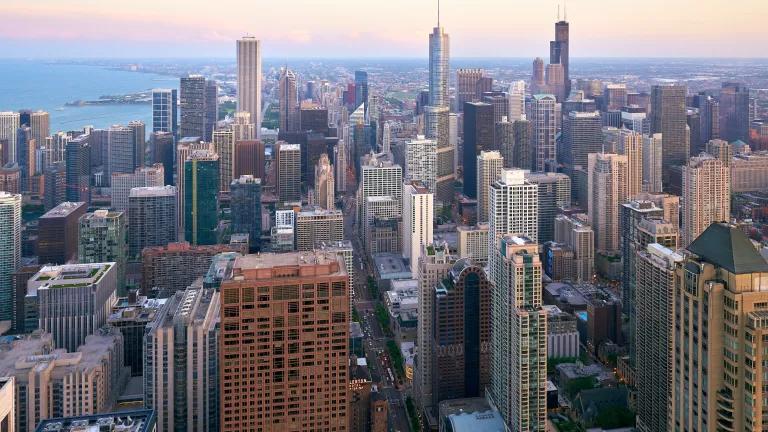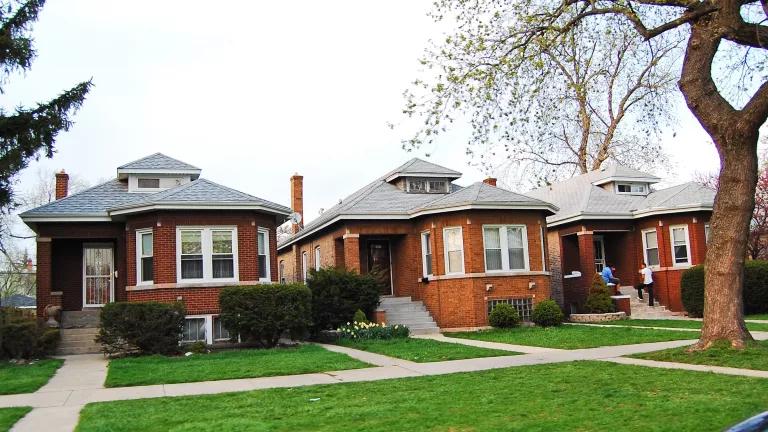Chicago Moves Forward on Clean Buildings
The Energy Transformation Code requires all new buildings in the city to comply with the energy efficiency standards set by the 2021 International Energy Conservation Code and to be built with the electrical capacity and wiring necessary to switch to all-electric appliances in the future.

Burkhardt Court Town Homes – Zero-Energy Ready Homes built by Brightleaf Construction
Mayor Lori Lightfoot and the Department of Buildings recently introduced the Chicago Energy Transformation Code, a building energy code that would ensure new buildings in Chicago are built to be clean, efficient, affordable, and aligned with long-term climate goals. This is the latest update to the city’s building code, which has been in place since 2019 and sets energy efficiency standards for new buildings in the city. This is a good step forward for the city of Chicago, but much remains to be done.
Building energy codes have been a vital tool for cities and states to reduce greenhouse gas emissions in buildings and ensure future building stock is being built to accommodate the installation of clean electric technologies, including electric vehicles, solar panels, and electric heat pumps for space heating and water heating.
The city of Chicago’s Climate Action Plan has committed to a goal of powering buildings community-wide with 100 percent renewable electricity by 2035. Currently, building emissions account for approximately 70 percent of Chicago’s citywide greenhouse gas (GHG) emissions. Buildings’ GHG emissions come from the burning of fossil fuels, such as propane and fracked methane gas (often referred to as “natural” gas), to power heating, cooking, and clothes-drying appliances. Replacing these appliances with efficient electric appliances reduces GHG emissions today and will continue to do so as the grid gets cleaner, thanks to the renewable electricity provisions in Illinois’s landmark Climate and Equitable Jobs Act and the city’s commitment to power all city-owned buildings with 100 percent renewable energy.
Alongside GHG emissions, the burning of gas and propane in homes also releases toxic air pollutants such as PM 2.5, nitrous oxides, and carbon monoxide, which, according to the American Medical Association, are harmful to human health and exacerbate respiratory health conditions, such as childhood asthma. Eliminating these emissions will not happen overnight and will require swift and immediate action to ensure we are able to meet our climate goals of tomorrow.
The new Energy Transformation Code brings the city of Chicago one step closer to zero-emissions buildings by requiring all new buildings to comply with the energy efficiency standards set by the 2021 International Energy Conservation Code (IECC)—resulting in a 40 percent improvement in energy efficiency compared to the 2001 ordinance—and to be constructed with the electrical capacity and wiring necessary to switch to electric appliances in the future.
Electric appliances for heating and cooking—such as cold-climate heat pumps, heat pump water heaters, induction stoves, and electric-resistance clothes-drying appliances—are cleaner and often more efficient than their gas and propane counterparts. This leads to long-term utility bill savings for tenants and homeowners, and even greater savings for those who go all-electric and can eliminate their gas bills entirely. The building energy code does not require buildings to be built with all-electric appliances today but does ensure that new buildings are built to accommodate these technologies in the future.
While this policy is an excellent step forward for the city of Chicago, there is much left to do in the transition to clean, fossil-free homes and buildings. With less than 13 years to reach the city’s 2035 climate goal, this will require swift passage of policies that take immediate action to eliminate the burning of fossil fuels in buildings (new and existing) today and accelerate the adoption of efficient electric appliances such as cold-climate heat pumps. It will also require funding and financing sources and technical support to help building owners, particularly owners of affordable housing, implement these changes equitably in a manner that maintains affordability for consumers.
This is only the first of many steps in the transition to clean electric buildings for the city of Chicago.



